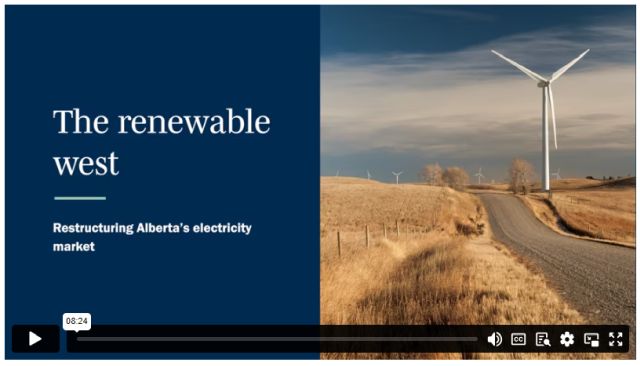Video transcript
Lou Cusano (00:05): Let's take a closer look at one of the major developments in Alberta's power industry, and what it means for renewable stakeholders.
Gino Bruni (00:13): Well, Lou, that would be the recommendation to restructure the energy only market into the restructured energy market, or "REM" for short. Lou, to start, what was the impetus for the REM?
Lou Cusano (00:24): Based on the AESO recommendation report and the related government announcements, there are a couple of things at play here. First, there is an ongoing concern regarding the price of electricity in terms of its volatility and high prices over the past few years. And second, the rise of intermittent forms of generation, such as solar and wind, has led to concerns about reliability and supply adequacy in the long term. And the recent brownouts in April have added to these concerns.
Gino Bruni (00:54): Right. So based on what we currently know about the restructured energy market, we think there are three main takeaways. First, the overall recommendation is to keep a restructure of the energy-only market. This means at least for the time being, generation will continue to be added by private companies in the province. Other market designs, such as a capacity market about which a major hearing was held by the AUC not long ago, have been ruled out.
However, the door has been left open for the AESO to enter long-term contracts in the future for controllable generation. Now what is controllable generation, Lou? Well, that is generation that can be dispatched and controlled in real time. Think of a natural gas plant that can be turned on or off in short order, as opposed to a wind farm that requires the wind to be blowing.
Lou Cusano (01:43): Since contracts for controllable generation could distort the price signals in the energy-only market, the AESO has cautioned that this should have clear and fixed boundaries and be a last resort only if needed, to meet supply needs. The AESO forecasts sufficient supply over the next decade, and while leaving the window open for procurement, the AESO would use contracting supply as a long-term action in the REM expected in the late 2020s or early 2030s. Again, only on an as needed basis.
Gino Bruni (02:16): Right. So, the second main takeaway of the restructured energy market is that the plan is to implement the design by the end of 2026. The AESO has acknowledged that this timeline is aggressive. The steps required to implement the REM are numerous and include developing new rules for the market after consulting with stakeholders, approval of those rules by the AUC, and building the IT systems required to operate that market. The latter alone, Lou, is expected to take at least 18 to 20 months.
Lou Cusano (02:46): The AESO has set out a plan based on what will happen in the near, medium and long term. In the near term or next six months to two years, interim market rules will be implemented to protect against the exercise of market power by large generation firms, and to address the intermittent nature of supply and promote reliability. These changes are the result of new regulations introduced in March, and the AESO rules necessary to effect such changes will be in place on July 1st, 2024.
In the medium 2 to 5 year time frame, the AESO will implement the REM. This will include finalizing the rules to account for the exercise of market power, and a suite of other changes to modernize the energy only market. And lastly, as already mentioned by Gino, in the long term or five plus years, the AESO will consider, if necessary, entering long-term contracts for controllable generation.
Gino Bruni (03:46): The third takeaway of the restructured energy market is that the devil will be in the details. The AESO has acknowledged that the elements proposed are conceptual and flexible. So, stakeholder engagement will be necessary to create the detailed design for the REM. In other words, Lou, there's much more to come on this.
Lou Cusano (04:04): Based on what we know now, what specific proposed changes in the REM should stakeholders of renewable power pay attention to?
Gino Bruni (04:12): Good question, Lou. The main thing is that there will be significant changes to how the pool price will be set in the restructured energy market. This will impact how renewable projects are paid for the power they produce in the market, and may also have implications for the power purchase agreements they enter into. So, in particular, the current cap of $999 per megawatt hour for the pool price will be raised through a mechanism called administrative scarcity pricing.
Now, the goal of this mechanism is to replace the economic withholding feature in our current market. And what that is, is that it permits generators to make offers at significantly higher prices than their marginal costs, so they are not dispatched and the pool price increases. The generation firm then benefits from higher prices for the electricity it does sell.
The AESO plans in the restructured energy market to eliminate economic withholding, and instead raise the price cap during certain hours when supply is low using this administrative scarcity pricing mechanism. These administratively set prices are aimed to incentivize controllable generation to be built or stay connected to the grid.
Lou Cusano (05:21): The REM also proposes to introduce negative pricing. A negative price means a generator pays for the grid to take its power. This is being introduced to help control periods when there is a supply surplus, and to incentivize the curtailing of generation. Renewables may be incentivized to bid at a negative price if they derive other benefits from producing, such as carbon offsets or other environmental attributes.
The thinking is that negative pricing will also incentivize battery storage, because it would be paid to charge during these negative priced hours.
Gino Bruni (05:28): Another key feature, and in order to provide additional certainty for generation and incentivize control generation, is that the REM will introduce a day ahead market. Now this will permit generators to make offers into the market a day in advance as opposed to in real time, under the current design. This would also impose penalties on generators who deviate from their committed generation supply. Lou, this will help the AESO control the supply that is coming online and required a day in advance.
Lou Cusano (06:29): Finally, the AESO has recommended changes to send improved locational signals for siting generation and allocating transmission costs. The AESO's counterpart, the Market Surveillance Administrator, has suggested that locational marginal pricing, which applies a different pool price to different areas of the province, be implemented. If this occurs, then this could have a significant impact on the economics of where generation is built in the province.
Again, to what extent these changes will impact the renewable projects will depend on the exact design and rules to implement the design. With this in mind, Gino, when can we expect such details to be fleshed out?
Gino Bruni (07:12): Well, first, the AESO plans to publish a draft restructured energy market design by the fall of 2024. That will provide some more clarity on some of the changes we discussed today and others. The AESO rules for the market will then be developed in 2025, which will provide us some further certainty.
Lou Cusano (07:32): To conclude, in addition to the upcoming details on the restructured energy market, the release of the Module B report is expected soon, which may lead to further legislative policy and regulatory changes. Developments regarding the Government of Canada's draft Clean Electricity regulations are also worthy of attention. In their current form, they would significantly reduce or eliminate the ability to use natural gas-fired generation starting in 2030.
This could have significant implications for the Alberta power market, and will undoubtedly create further constitutional conflict between the two levels of government. In other words, stay tuned for further changes and announcements impacting the Alberta power market. Thank you, Gino, and thanks for watching.
The content of this article is intended to provide a general guide to the subject matter. Specialist advice should be sought about your specific circumstances.



